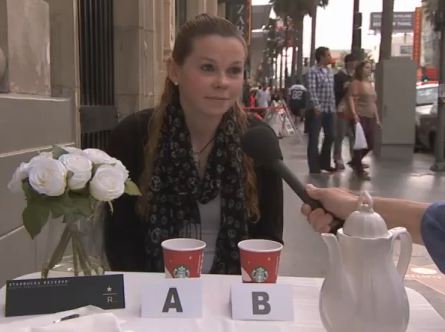A couple of months back I posted a video that illustrated the way that our expectations shape our perceptions. In it, Jimmy Kimmel gave people an iPhone 4 but told them it was an iPhone 5. Believing they were holding a neat new Apple product, they identify a range of features that make it clearly superior — often holding it up to their identical iPhone 4s and perceiving significant differences between the two.
Following up on this theme, Kimmel followed up by asking people on the street to try two cups of coffee and tell him which one had the new $7-per-cup premium coffee from Starbucks and which had a cheap brand. Except both cups of coffee were actually full of the same, non-premium, non-Starbucks coffee. Nonetheless, a number of testers immediately identify striking differences in taste between the two options, providing specific differences in quality that they think distinguish the coffees. It’s a fun illustration of a basic aspect of human cognition — that what we expect to see or experience affects how we interpret the sensory information we encounter:
Thanks to Dmitriy T.C. for the tip!
Gwen Sharp is an associate professor of sociology at Nevada State College. You can follow her on Twitter at @gwensharpnv.

Comments 14
Rathi — December 7, 2012
This experiment is actually a clever one. It lets us understand how our brains work when we want to distinguish between two same things. Good one!
Sartora — December 7, 2012
I wonder how far you could go. Would users believe you if you said one was an iPhone 3 and the other an iPhone 5? What about first iPhone versus most recent? If you hid the branding logo, would they mistake a Galaxy phone for an iPhone?
There comes a point where you can't pull this anymore, of course ("What? No, this isn't a Nexus 10, it really is an iPhone 5!"), but it would be neat to see just how far one could push this effect.
Jcov154 — December 7, 2012
I think it says a lot about trust or perhaps authority. Unless they thought they were being "punked" why would you think someone is lying to you about there even being 2 different kinds of coffee. This set up presents a Starbucks representative (who else would be sampling Starbucks coffee except a TV "comedian" trying to get a laugh at your expense?) telling you there are 2 different kinds of coffee, why would someone question this? It would not bode well for the company to lie (even though it was Kimmel). Reminds me of a quasi-experiment where people are influenced by authority or position.
Elena — December 7, 2012
In other words, the placebo effect is not limited to sugar pills.
Seven87eight — December 7, 2012
There's an episode of Penn and Teller: Bullshit that runs a similar experiment...actually two episodes. the Bottled Water episode runs a hidden camera experiment where the "water steward" explains the qualities of different bottles of water and has the customers taste and compare. They all pick out different subtleties, despite the bottles all being filled with tap water.
The other episode (I want to say it was about The Best things vs. lower-quality) served customers what they were told was five-star food (filet mignion, lobster, white chocolate mousse) but was actually cheap and low-quality (skirt steak, monkfish, cool whip). The customers loved the meal and praised how much it was worth the price.
Antisoc — December 8, 2012
Humans are dumbfucks, news at 11.
Rae — December 8, 2012
The same effect is used with Almay Smart Shade makeup, with a sort of racist twist: The makeup is, supposedly, able to magically adjust to the user's skin tone. However, it's an illusion created by the fact that the makeup starts white/grey and as the pigment is dispersed by spreading it around on the user's face, it "changes" to look more like their skin tone. The irony is that this actually comes in only one shade per skin tone, as opposed to with "warm", "cool", and "neutral" undertones with each shade, because of course that would give it away. And the racist twist is that although the makeup is supposed to be self-adjusting, it only comes in "light", "medium light", and "medium" skin tones!
Cactus_Wren — December 11, 2012
Brian Wansink, in his book "Mindless Eating: Why We Eat More Than We Think", describes a study in which he and his colleagues discovered that diners not only bought more of "Traditional Cajun Red Beans and Rice", "Succulent Italian Seafood Filet", or "Home Style Chicken Parmesan" than of "Red Beans and Rice", "Seafood Filet" or "Chicken Parmesan", they actually rated them as better (although the dishes were identical), considered them "better values" at the same price, and thought better of *the restaurant that served them*, some even suggesting that the cafeteria chef must have been classically trained.
Gynomite’s Reading Room « Gynomite! — December 11, 2012
[...] Kimmel is doing genius things with confirmation bias these days. You should check it [...]